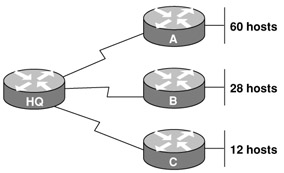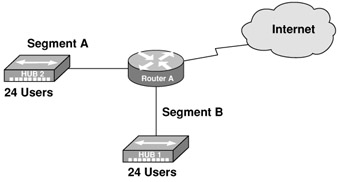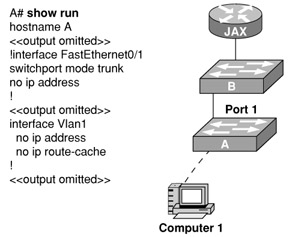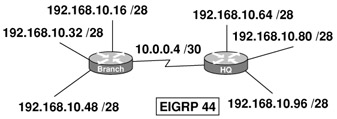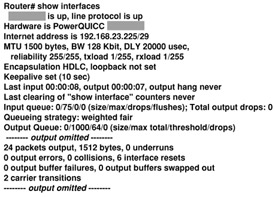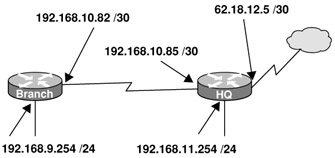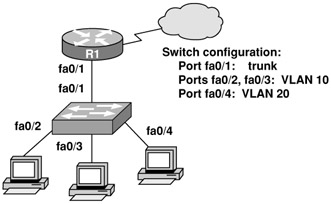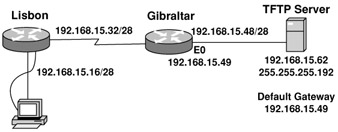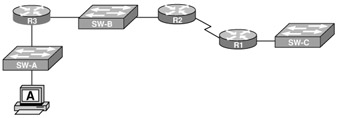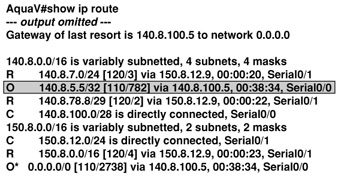CCNA-Practice Test 5
Directions: For each of the following questions, select the choice that best answers the question or completes the statement.
| 1. | Look at the following diagram. A Class C address has been assigned for use in the network shown. Which subnet mask should be used to provide valid IP addresses for the number of hosts connected to router A, while wasting the fewest addresses?
| | ||||
| 2. | Look at the following diagram. What will be the effect of replacing the hubs with switches in the network? (Choose two.)
| | ||||
| 3. | Your router discovers a remote network via a static route, EIGRP, and OSPF, and all the routing protocols are set to their default administrative distance. In this situation, which route will the router use to forward data to the newly discovered remote network?
| | ||||
| 4. | The ISKI Corporation is configuring the serial interface of a Cisco router to connect to the router of a new ISP. After issuing the showinterfaces serial 0/0 command, it is observed that the interface is up and the line protocol is down. Which of the following commands will fix this problem?
| | ||||
| 5. | Choose three of the following that accurately describe RIP.
| | ||||
| 6. | Given a subnet mask of 255.255.255.224, which of the following addresses can be assigned to network hosts? (Chose three.)
| | ||||
| 7. | Look at the following diagram. RTR-1 has been properly configured with static routing. Which set of commands will configure RTR-2 with static routing to reach the RTR-1 networks?
| | ||||
| 8. | Which of the following are key characteristics of PPP? (Choose three.)
| | ||||
| 9. | Look at the following diagram. Computer 1 is consoled into switch A. Telnet connections and pings run from the command prompt on switch A fail. Which of the following could cause this problem?
| | ||||
| 10. | What will an Ethernet switch do if it receives a unicast frame with a destination MAC that is not listed in the switch table?
| | ||||
| 11. | In a spanning-tree topology, which of the following can you use to delimit the root port on each non-root switch?
| | ||||
| 12. | Which of the following is the reason you should configure port security on a switch?
| | ||||
| 13. | Which type of EIGRP route entry describes a feasible successor?
| | ||||
| 14. | What can be done to secure the virtual terminal interface on a router? (Choose two.)
| | ||||
| 15. | Which characteristics are representative of a link-state routing protocol? (Choose three.)
| | ||||
| 16. | Look at the following diagram. A network technician is asked to design a small network with redundancy. The exhibit represents this design, with all hosts configured in the same VLAN. What conclusion can be made about this design?
| | ||||
| 17. | Look at the following diagram. A network technician has issued the command show ip route. The technician is trying to discover why packets are not getting to the 172.16.2.0 network. What could be the problem?
Figure 5-6 | | ||||
| 18. | Look at the following diagram. An internetwork has been configured as shown in the diagram, with both routers using EIGRP routing for AS 44. Users on the Branch router are unable to reach any of the subnets on the HQ router. Which of the following commands is necessary to fix this problem?
| | ||||
| 19. | In which of these situations will numerous copies of the same unicast frame be transmitted over a switched LAN?
| | ||||
| 20. | Look at the following diagram. Which two values indicate that this router output refers to a WAN interface? (Choose two.)
| | ||||
| 21. | Look at the following diagram. A router interface is being configured for Frame Relay. However, as the exhibit shows, the router will not accept the command to configure the LMI type. What is the problem?
Router(config)# interface serial 0/0 Router(config-if)# frame-relay Imi-type cisco ^ % Unrecognized command Router(config-if)# frame-relay ? % Unrecognized command Figure 5-9 | | ||||
| 22. | All WAN links inside the ABC Corporate network use PPP with CHAP for authentication security. Which command displays the CHAP authentication process as it occurs between two routers in the network?
| | ||||
| 23. | Look at the following router output obtained via the show frame-relay map command, and choose the answer that best describes what the term dynamic means:
Vine#show frame-relay map Serial0/0 (up): ip 192.168.10.1 dlci 16 (0x64, 0x1840), dynamic Broadcast, status defined, active
| | ||||
| 24. | The Winery Coop has five branches throughout Napa and Sonoma, and the company wants to build a WAN to give it a completely meshed environment with a minimum of 512Kbps throughput. It also needs the most cost-effective solution. Which WAN service should the company choose?
| | ||||
| 25. | Based on the following switch output, how did the switch receive the MAC table entry for 0012.7f4b.6882? Code Listing 5-1
Switch#sh mac address-table Mac Address Table ------------------------------------------- Vlan Mac Address Type Ports ---- ----------- -------- ----- All 0005.dccb.d740 STATIC CPU All 0100.0ccc.cccc STATIC CPU All 0100.0ccc.cccd STATIC CPU All 0100.0cdd.dddd STATIC CPU 1 000a.f467.9e80 DYNAMIC Fa0/11 1 0010.7b7f.c2b0 DYNAMIC Fa0/11 1 0012.7f4b.6880 DYNAMIC Fa0/11 1 0012.7f4b.6881 DYNAMIC Fa0/11 1 0012.7f4b.6882 DYNAMIC Fa0/11 1 0030.80dc.460b DYNAMIC Fa0/11 1 0030.9492.a5dd DYNAMIC Fa0/2 1 00d0.58ad.05f4 DYNAMIC Fa0/1 Total Mac Addresses for this criterion: 12 Switch#
| | ||||
| 26. | You're adding a new router into an OSPF network, and the networks connected to your new router aren't showing up in the routing tables of the other OSPF routers. You have the subnets 10.10.10.0/24 and 10.11.11.0/24. What should your OSPF configuration be if you want to create one network entry and place both subnets into area 0?
| | ||||
| 27. | Which of the following commands configures a default route to any destination network not found in the routing table?
| | ||||
| 28. | Look at the following diagram. After the router interfaces shown in the diagram have been configured, it is discovered that hosts in the Branch LAN cannot access the Internet. Further testing reveals additional connectivity issues. What will fix this problem?
| | ||||
| 29. | You need to keep the hosts with the subnet address 172.16.24.0/21 in the VLAN from accessing Telnet services. Which of the following provides the missing answers in this command?
access-list 110 deny protocol 172.16.24.0 mask any eq port
| | ||||
| 30. | Look at the following diagram. The router has been configured to provide communication between the VLANs. Which IOS commands are required to configure switch port fa0/1 to establish a link with router R1 using the IEEE standard protocol? (Choose three.)
| | ||||
| 31. | Why would you use this command?
ip route 0.0.0.0 0.0.0.0 serial0/0
| | ||||
| 32. | An inbound access list has been configured on a serial interface to deny packet entry for TCP and UDP ports 21, 23, and 25. What types of packets will be permitted by this ACL? (Choose three.)
| | ||||
| 33. | You're faced with reconfiguring a Catalyst 2950. Pick three steps that will guarantee the old configuration is erased.
| | ||||
| 34. | If you were implementing VLSM on a network with a single Class C IP address, which subnet mask would you use to create the most effective point-to-point serial link?
| | ||||
| 35. | A network administrator has installed a new router in the Lisbon office and is unable to back up the IOS image of the new router to a TFTP server located in the Gibraltar office. Given the network diagram, identify the source of the problem.
| | ||||
| 36. | In which spanning-tree states does a switch port learn MAC addresses? (Choose two.)
| | ||||
| 37. | You've subnetted your client's internetwork using 29 bits. You now need to configure an extended access list to control access to a whole subnetwork. To achieve this, which of the following wildcard masks should you use?
| | ||||
| 38. | Look at the following diagram. A network technician is troubleshooting a connectivity problem on R2. The technician enters the show cdp neighbors command at the R2 console. If the network is composed only of Cisco devices, for which devices should entries be displayed?
| | ||||
| 39. | Look at the following output, and pick the option that solves the problem of why Serial0/0 won't respond to a ping from a machine on the FastEthernet0/0 LAN. Code Listing 5-2
Napa#sh ip interface brief Interface IP-Address OK? Method Status Protocol Ethernet0/0 192.168.10.1 YES NVRAM up up Serial0/0 192.168.15.1 YES NVRAM administratively down down Serial0/1 192.168.16.1 YES NVRAM up up Serial0/2 unassigned YES NVRAM administratively down down Router#
| | ||||
| 40. | A network administrator wants the text "Unauthorized access prohibited!" to be displayed before the login prompt when someone tries to initiate a Telnet session to a router. Which command can be used to configure this message?
| | ||||
| 41. | Look at the following diagram. The two connected ports on the switch are not turning orange or green. What will be the most effective steps to troubleshoot this Physical layer problem? (Choose three.)
| | ||||
| 42. | Choose two of the following options that accurately describe the tasks that the OSPF Hello protocol performs.
| | ||||
| 43. | Which type of EIGRP route entry describes a feasible successor?
| | ||||
| 44. | What does a layer-2 switch do if it receives a frame with a destination MAC address that is not found in its MAC address table?
| | ||||
| 45. | You've created the access list shown below and applied it to an interface. Which of the following are denied based on the access list?
access-list 107 deny tcp 207.16.12.0 0.0.3.255 any eq http access-list 107 permit ip any any
| | ||||
| 46. | On three different occasions, an administrator configured a router and, after testing the configuration, saved it to NVRAM by issuing the copy running-config startup-config command. After each successful save, the administrator issued the reload command. Each time, when the router restarted, the router appeared to have the default blank configuration. What could cause such results?
| | ||||
| 47. | The OSPF Hello protocol performs which of the following tasks? (Choose two.)
| | ||||
| 48. | What is the purpose of this command?
ip route 0.0.0.0 0.0.0.0 serial0/0
| | ||||
| 49. | Choose the three services that use TCP.
| | ||||
| 50. | Look at the following diagram. How should the FastEthernet0/1 ports on the 2950 model switches that are shown in the exhibit be configured to allow connectivity between all devices?
| | ||||
| 51. | Look at the following diagram. What does the number 782 represent?
| | ||||
| 52. | When setting up Frame Relay for point-to-point subinterfaces, which of the following must not be configured?
| | ||||
| 53. | What is the purpose of the OSPF router ID in a DR/BDR election?
| | ||||
| 54. | Select the statements that correctly describe full- or half-duplex Ethernet operation. (Choose two.)
| | ||||
| 55. | Of the choices below, which one is needed for connectivity in a Frame Relay network if Inverse ARP isn't operational?
| |
Answers
| 1. | C Explanation: C. A /26 mask allows for up to 62 hosts. |
| 2. | A, B Explanation: A, B. Switches decrease the number of collisions and increase the effective bandwidth each individual host has. |
| 3. | A Explanation: A. Administrative Distance (AD) is the value a router uses to differentiate between routing information. Each routing protocol is given a value; a static route has the best AD: 1 (the lower, the better; only a directly connected network is better, with an AD of 0). |
| 4. | C Explanation: C. The default encapsulation is HDLC on Cisco routers, which is proprietary. Changing to PPP encapsulation (amore universal standard) is the most likely choice to resolve the up/down issue here. |
| 5. | A, B, F Explanation: A, B, F. RIPv1 is a classful routing protocols, which means all masks on every host in the network must be exactly the same. RIPv1 sends broadcasts, and RIPv2 uses multicast: 224.0.0.9. RIP has many loop-avoidance mechanisms, some of which are split-horizon and hold-down timers. Others include route poison, setting infinity, and triggered updates. RIPv2 supports authentication as well; v1 does not. |
| 6. | B, C, D Explanation: B, C, D. With a /27 mask, you must ensure that the last 5 bits are not all ones (broadcast address) or zeros (network address). A and E are both all ones, and F is all zeros. |
| 7. | D Explanation: D. The correct routes are for the two networks (192.168.35.0 and 192.168.35.32 along with correct masks) via the RTR-1 serial interface IP address. |
| 8. | A, C, E Explanation: A, C, E. PPP can be used over analog circuits, supports multiple routed (layer 3) protocols, and uses a CRC to provide error correction. |
| 9. | D Explanation: D. Telnet and ping require that switch A has a valid IP configuration. The default gateway and CDP are not relevant here. Also, a trunk port is not required to ping or telnet. |
| 10. | E Explanation: E. When the destination MAC of a unicast frame is unknown, the switch forwards the frame on all ports except the one on which it was received. |
| 11. | A Explanation: A. Path cost is the first value that is used to determine which port should be blocking or forwarding. If path cost does not differentiate, then bridge id and port id can be used. |
| 12. | C Explanation: C. Port security can prevent unauthorized hosts from accessing the LAN. It can be configured with a maximum number of MAC addresses per port, or to allow only specifically configured MACs access. |
| 13. | C Explanation: C. A feasible successor is stored in EIGRP's topology table, which holds all links known in the autonomous system. A successor route is copied from the topology table and placed in the routing table, which is then used by IP to route packets. The feasible successor is the backup route to the successor route. |
| 14. | D, E Explanation: D, E. The virtual terminal can be secured with a password. Additionally, you can control source IP addresses that have access to the VTY using a standard IP access list and the access-class command. |
| 15. | A, C, D Explanation: A, C, D. Link-state routing protocols calculate a view of the entire topology, calculate shortest paths, and use event-triggered (not periodic) updates. |
| 16. | C Explanation: C. You cannot assign two interfaces on the same router addresses in the same subnet, or IOS will generate an error. |
| 17. | D Explanation: D. Without a route to the destination or a default route, the router will drop packets. |
| 18. | B Explanation: B. The no auto-summary command must be used when subnetworks are not contiguous. |
| 19. | D Explanation: D. If you have switches connected with dual links, and STP is not running, then you will have broadcast storms, multiple frame copies, and MAC table instability. |
| 20. | B, E Explanation: B, E. The bandwidth is below that of any LAN interface, and the encapsulation (HDLC) is not used on LAN interfaces. |
| 21. | D Explanation: D. Until the interface is configured with Frame Relay encapsulation, none of the more specific Frame Relay commands will be functional. |
| 22. | C Explanation: C. You must use a debug command show the authentication as it happens. In this case, the "debug ppp authentication" command. |
| 23. | E Explanation: E. Inverse ARP is the automatic process of finding a DLCI from a known IP address. If this function is not available, then the mapping of the DLCI to the IP address must be done manually through the frame-relay map command. |
| 24. | A Explanation: A. The bandwidth requirement and the fact that it is to be cost effective make Frame Relay the only real choice. |
| 25. | A Explanation: A. The best answer is that the MAC address was forwarded from another switch, because port Fa0/11 has many MAC addresses associated with it. |
| 26. | D Explanation: D. Although answer C is close, only answer D is correct because you must have a space after the command area before listing the associated area. |
| 27. | D Explanation: D. A default route is a static route where the destination network and mask are all zeros. |
| 28. | B Explanation: B. The correct address should be 192.168.10.86. |
| 29. | A, D, F Explanation: A, D, F. To answer this question, you must know what a /21 is. A /21 is 255.255.248.0, which is a block size of 8, wildcard of 7, in the third octet (wildcards are always one less than the block size). Telnet uses TCP at the Transport layer and is well-known port number 23. |
| 30. | A, C, F Explanation: A, C, F. The interface must be configured as a trunk link, and the encapsulation must be specified. |
| 31. | D Explanation: D. The ip route command with all zeros is a default route. Any traffic without a specific route is sent out the interface specified at the end of the command. A next hop can also be used with the command instead of the exit interface. |
| 32. | D, E, F Explanation: D, E, F. Ports 21, 23, and 25 are associated with FTP, Telnet, and SMTP; and because the ACL is denying these packets, these protocols will not work. |
| 33. | B, C, E Explanation: B, C, E. A typical router can be set back to factory defaults by erasing the startup-config in NVRAM and then reloading the device. However, a switch keeps the VLAN database in flash; so, that must also be deleted on a switch to set the switch back to factory defaults. |
| 34. | D Explanation: D. A /30 or 255.255.255.252 provides only two hosts, regardless of the class of address, which is perfect for a point-to-point link. |
| 35. | B Explanation: B. The subnet mask for a /28 network is 255.255.255.240, not 255.255.255.192. |
| 36. | C, D Explanation: C, D. In the learning and forwarding states, a switchport can learn MAC addresses. |
| 37. | E Explanation: E. First, you must know what a /29 is. The mask is 255.255.255.248, which means the block size is 8 in the fourth octet. A wildcard is always one less the block size, so the answer is 0.0.0.7. |
| 38. | B Explanation: B. The R2 router should have SW-B and R1 as CDP neighbors. |
| 39. | A Explanation: A. If an interface is administratively down, this means the interface is not enabled and must be enabled with the no shutdown command. All interfaces on a router are shut down by default. |
| 40. | C Explanation: C. The banner motd command allows you to configure a message of the day. |
| 41. | B, D, F Explanation: B, D, F. When the switchports fail to turn orange or green, it indicates a layer 1 problem. The wrong cable type or poorly seated cables can cause this issue, as can the switch not having power. |
| 42. | A, C Explanation: A, C. A router running a link-state protocol uses hello packets to dynamically find neighbors and form adjacencies. Once an adjacency has been formed, the router uses link state advertisement (LSA) packets to exchange topology information and updates when changes occur. |
| 43. | C Explanation: C. A feasible successor is stored in EIGRP's topology table, which holds all links known in the autonomous system. A successor route is copied from the topology table and placed in the routing table, which is then used by IP to route packets. The feasible successor is the backup route to the successor route. |
| 44. | C Explanation: C. A LAN switch uses MAC addresses to segment the network into collision domains. The switch looks at the source MAC address of each frame received on a port and places this in a forward/filter table, also called the content addressable memory (CAM) table. If a frame is received and the destination hardware (MAC) address is not found in the CAM table, the frame is sent out all ports except the port it was received on. |
| 45. | A, B, E Explanation: A, B, E. The wildcard in the mask is the key to the answer. 0.0.3.255 means that the third octet has a wildcard of 4. The 12 in the third octet means that the access-list will match 12, 13, 14, and 15, which make C and D permitted and A, B, E incorrect. B is wrong because the port number is wrong. A isn't in the correct block size; and E is 16, which is one more than the allowed block size. |
| 46. | C Explanation: C. If the configuration register setting is incorrect, it is possible that the router will boot and ignore the startup-config. |
| 47. | A, C Explanation: A, C. A router running a link-state protocol uses hello packets to dynamically find neighbors and form adjacencies. Once an adjacency has been formed, the router uses link state advertisement (LSA) packets to exchange topology information and updates when changes occur. |
| 48. | D Explanation: D. This is known as a default route. It configures the router to send all packets for which the router does not have a specific route out the serial0/0 interface. |
| 49. | B, D, E Explanation: B, D, E. SMTP, FTP, and HTTP are Application layer protocols that use TCP at the Transport layer. DHCP, SNMP, and TFTP all use UDP at the Transport layer. |
| 50. | B Explanation: B. Specifying that the switchports are trunk links makes them able to carry all VLAN traffic. By default, they carry all VLANs. |
| 51. | C Explanation: C. In this case, the 782 represents the OSPF cost of this route. |
| 52. | C Explanation: C. When you are creating subinterfaces on a router, an IP address is not configured under the physical interface of the router. IP addresses can be configured only under the logical (subinterfaces) interfaces, or the network will not function. |
| 53. | C Explanation: C. When OSPF is configured on a router, a router identification (RID) is created by using the highest IP address on any active interface at the moment of OSPF startup. The RID can be changed by creating a loopback interface, also called a logical interface. Routers use this RID to determine which router will be a designated router or backup-designated router in a broadcast or nonbroadcast multiaccess network. |
| 54. | B, D Explanation: B, D. Full-duplex Ethernet uses two pairs of wires. In full-duplex Ethernet, there is no such thing as a collision. Half-duplex Ethernet does use CSMA/CD, does have collisions, and must use a loopback circuit to detect collisions. |
| 55. | B Explanation: B. Inverse ARP is used to resolve an IP address to local DLCI number. If a router does not support IARP or is used on the network, a Frame Relay map must be configured for each PVC. |
